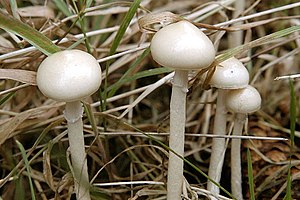Hemispherical Trümmling
| Hemispherical Trümmling | ||||||||||||
|---|---|---|---|---|---|---|---|---|---|---|---|---|

Hemispherical Trussling ( Protostropharia semiglobata ) |
||||||||||||
| Systematics | ||||||||||||
|
||||||||||||
| Scientific name | ||||||||||||
| Protostropharia semiglobata | ||||||||||||
| (Quél.) Redhead, Moncalvo, Vilgalys |
The hemispherical Trärmling ( Protostropharia semiglobata, syn .: Stropharia semiglobata, Stropharia stercoraria ) is a species of fungus from the genus Protostropharia and the type of the genus.
features
The hemispherical Trüsselling forms fruiting bodies with hemispherical, 1–4 cm wide hats that become flat with age, the top of which is lemon to ocher yellow with a delicate ocher apex. The surface of the hat is wet and sticky, and when dry, it is silky and shiny. The stem becomes 5–15 cm long and 2.5–7 mm thick; it is rigid, hollow and brittle. Above the ring zone, the stalk is cream-colored to lightly loose and smooth, below that it is very slimy-sticky and possibly fine, light-brown, scaly fibers with a cream-colored background. The wide lamellas run almost horizontally from the edge of the hat to just in front of the handle and only then up to the tip of the handle. You are whitish young; the spore powder turns them gray with a bluish-purple tone, in old specimens they turn dark brown with a wine-red tone.
The thick-walled spores, which appear brown under the microscope, measure 15.5–21 × 7–11.5 µm and have a large, pronounced germ pore located in the center of the end of the spore. Chrysocystids occur in both the hymenium and the tip of the stem. In contrast to Trärmlingen in the narrow sense (genus Stropharia ), there are no acanthocysts in the mycelium, but astrocystids.
ecology
The hemispherical Trüsselling is a manure inhabitant that occurs on fat meadows, pastures, turf, on roadsides, in gardens and parks and similar grassy places and is particularly common in the Alps on cattle pastures. The hemispherical Trüsselling prefers cattle manure as a substrate, but in contrast to other members of the Protostropharia genus, it is very unspecific and can also rely on manure from other animals, such as. B. also occur on horse manure. The fruiting bodies appear in Central Europe from early summer to autumn.
distribution
The hemispherical truss is a cosmopolitan species on various dung. It was introduced in Australia and South America. In Europe, the species is found from southern and southeastern Europe north to Scandinavia, Iceland and the Faroe Islands, to the east it occurs to Estonia and Belarus. In Germany, the hemispherical Trüsselling can be found scattered to widespread.
Species delimitation
The representatives of the genus Protostropharia usually look very similar, so that a microscopic examination is usually necessary to determine the species. Earlier determinations carried out only macroscopically should therefore, if possible, be checked retrospectively. Protostropharia luteonitens can be macroscopically differentiated by the pseudosclerotium it forms and by a conspicuous, pointed papilla in the middle of the hat. Protostropharia islandica lacks the chrysocystids occurring in the other members of the genus. It is known from Iceland and grows there on horse manure. Protostropharia arctica , which is noticeably short-stemmed and can be recognized by particularly short spores , is also widespread in the arctic . Protostropharia alcis grows on elk and red deer dung and can be recognized by its particularly narrow spores. Protostropharia dorsipora differs in particular in that it has a conspicuously asymmetrically attached germ pore, shifted dorsally at the end of the spore, and preferably horse manure. A distinguishing feature is the flour-like smell of the crushed lamellas, which the hemispherical Trümmling lacks. Protostropharia ochraceoviridis also prefers horse manure and can only be distinguished macroscopically on the basis of the mixed green tones of the cap skin and the not smooth, but later indicated scaly cap skin.
Systematics
The genus Protostropharia is genetically clearly demarcated from the Trümmlings in the narrow sense, but is together with them in the family of the Trärmling relatives (Strophariaceae).
Earlier (still under the previous assignment to the Trüssellingen) the varieties Stropharia semiglobata var. Stercoraria and Stropharia semiglobata var. Siccipes were differentiated. The former, sometimes even separated at the species level, cannot be demarcated morphologically and ecologically as an independent one and is therefore viewed as a synonym, while the latter is part of the Deconica merdaria group and has nothing to do with the hemispherical Trümmling.
meaning
The hemispherical Trümmling is not an edible mushroom; it may be slightly poisonous. As manure dwellers, the fruiting bodies can in any case be contaminated with the eggs of parasitic worms of the grazing animals, which means a risk of infection.
swell
- Hans E. Laux: The great cosmos mushroom guide. All edible mushrooms with their poisonous doppelgangers. Franckh-Kosmos, Stuttgart 2001, ISBN 3-440-08457-4 .
- German Josef Krieglsteiner (Ed.), Andreas Gminder : Die Großpilze Baden-Württemberg . Volume 4: Mushrooms. Blattpilze II. Ulmer, Stuttgart 2003, ISBN 3-8001-3281-8 .
- Josef Breitenbach, Fred Kränzlin (Ed.): Mushrooms of Switzerland. Contribution to knowledge of the fungal flora in Switzerland. Volume 4: Agarics. Part 2: Entolomataceae, Pluteaceae, Amanitaceae, Agaricaceae, Coprinaceae, Bolbitiaceae, Strophariaceae. Mykologia, Luzern 1995, ISBN 3-85604-040-4 .
Individual evidence
- ↑ a b c d e f I. Kytövuori: The Stropharia semiglobata group in NW Europe . In: Karstenia . tape 41 , 1999, p. 11-32 .
- ^ A b Scott A. Redhead: Nomenclatural novelties . In: Index Fungorum . tape 15 , 2013, p. 1–2 ( indexfungorum.org [PDF]).
- ↑ a b c d e Christoph Hahn: A Bavarian record of Protostropharia dorsipora with notes on the genus Protostropharia and an annotated identification key . In: Mycologia Bavarica . tape 15 , 2014, p. 19-32 .
- ^ Jean-Marc Moncalvo, Rytas Vilgalys, Scott A Redhead, James E Johnson, Timothy Y James: One hundred and seventeen clades of euagarics . In: Molecular Phylogenetics and Evolution . tape 23 , no. 3 , June 2002, p. 357-400 , doi : 10.1016 / S1055-7903 (02) 00027-1 ( umich.edu [PDF]).